Accounting for Managers: Analysis of Financial Statements Report
VerifiedAdded on 2020/03/28
|14
|3720
|38
Report
AI Summary
This report, prepared for an accounting for managers course, provides a comprehensive analysis of financial statements, ethical considerations, and accounting software solutions. The report begins with an analysis of Efficient Distributors Ltd's financial performance using ratio analysis, highlighting profitability, liquidity, and efficiency trends over three years. It then addresses ethical dilemmas faced by an accountant, Tom, at Allandale Ltd, focusing on the implications of asset valuation and debt recovery on financial reporting and compliance with loan agreements. The report recommends ethical courses of action. Finally, the report explores accounting software options for Giggling Brothers, detailing system benefits, implementation recommendations, stakeholder involvement, and competitor analysis. The analysis covers financial performance, ethical decision-making, and technological solutions, making it a valuable resource for understanding key aspects of accounting and financial management.
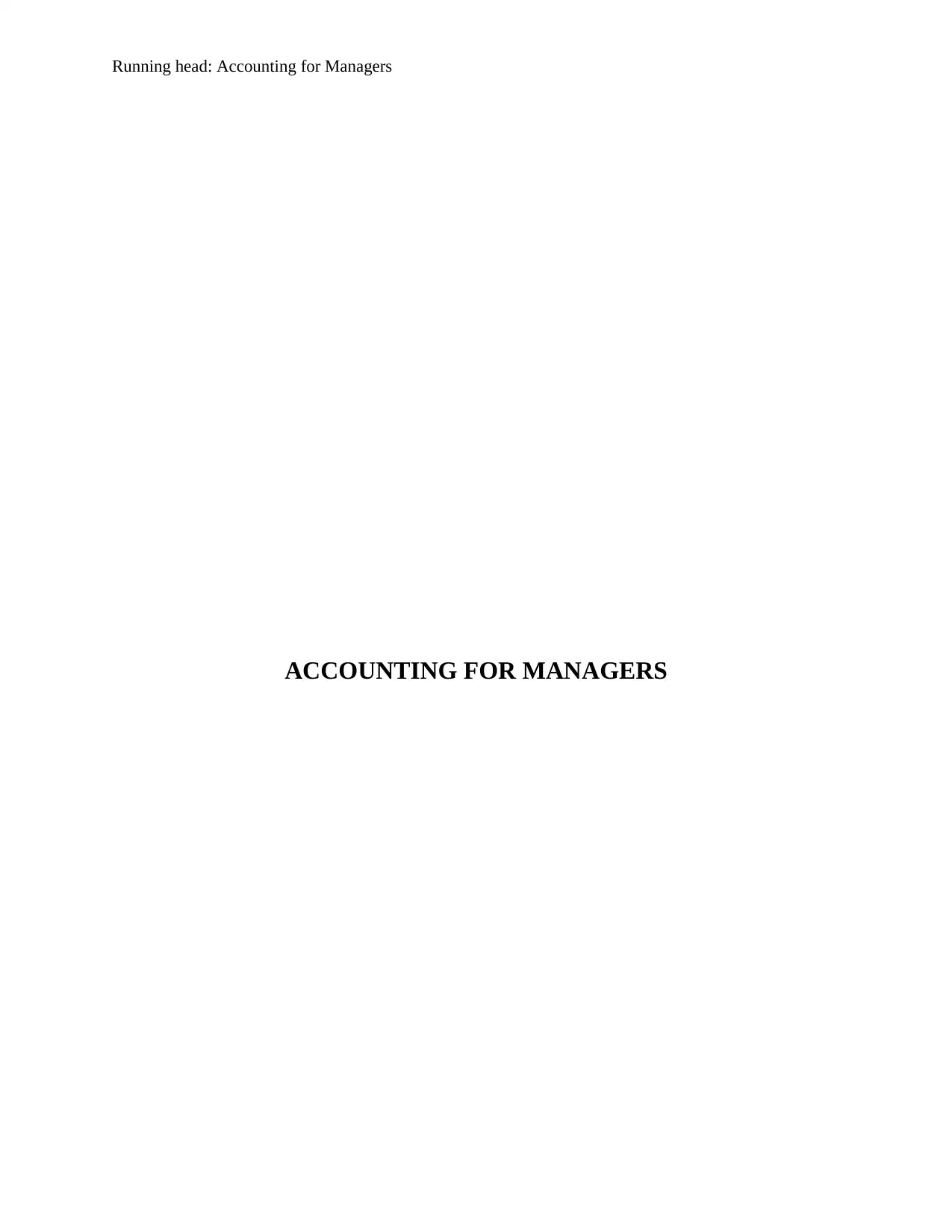
Running head: Accounting for Managers
ACCOUNTING FOR MANAGERS
ACCOUNTING FOR MANAGERS
Paraphrase This Document
Need a fresh take? Get an instant paraphrase of this document with our AI Paraphraser
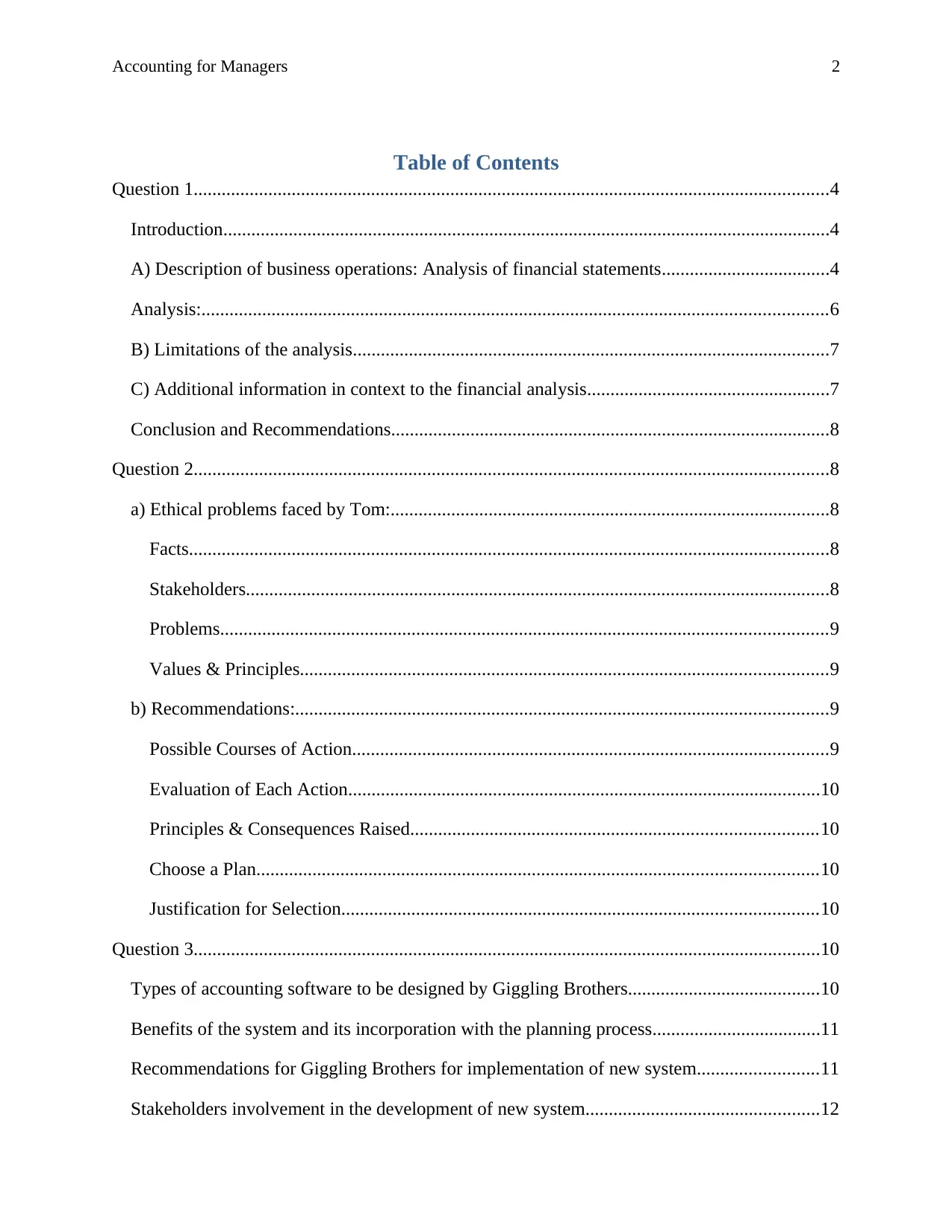
Accounting for Managers 2
Table of Contents
Question 1........................................................................................................................................4
Introduction..................................................................................................................................4
A) Description of business operations: Analysis of financial statements....................................4
Analysis:......................................................................................................................................6
B) Limitations of the analysis......................................................................................................7
C) Additional information in context to the financial analysis....................................................7
Conclusion and Recommendations..............................................................................................8
Question 2........................................................................................................................................8
a) Ethical problems faced by Tom:..............................................................................................8
Facts.........................................................................................................................................8
Stakeholders.............................................................................................................................8
Problems..................................................................................................................................9
Values & Principles.................................................................................................................9
b) Recommendations:..................................................................................................................9
Possible Courses of Action......................................................................................................9
Evaluation of Each Action.....................................................................................................10
Principles & Consequences Raised.......................................................................................10
Choose a Plan........................................................................................................................10
Justification for Selection......................................................................................................10
Question 3......................................................................................................................................10
Types of accounting software to be designed by Giggling Brothers.........................................10
Benefits of the system and its incorporation with the planning process....................................11
Recommendations for Giggling Brothers for implementation of new system..........................11
Stakeholders involvement in the development of new system..................................................12
Table of Contents
Question 1........................................................................................................................................4
Introduction..................................................................................................................................4
A) Description of business operations: Analysis of financial statements....................................4
Analysis:......................................................................................................................................6
B) Limitations of the analysis......................................................................................................7
C) Additional information in context to the financial analysis....................................................7
Conclusion and Recommendations..............................................................................................8
Question 2........................................................................................................................................8
a) Ethical problems faced by Tom:..............................................................................................8
Facts.........................................................................................................................................8
Stakeholders.............................................................................................................................8
Problems..................................................................................................................................9
Values & Principles.................................................................................................................9
b) Recommendations:..................................................................................................................9
Possible Courses of Action......................................................................................................9
Evaluation of Each Action.....................................................................................................10
Principles & Consequences Raised.......................................................................................10
Choose a Plan........................................................................................................................10
Justification for Selection......................................................................................................10
Question 3......................................................................................................................................10
Types of accounting software to be designed by Giggling Brothers.........................................10
Benefits of the system and its incorporation with the planning process....................................11
Recommendations for Giggling Brothers for implementation of new system..........................11
Stakeholders involvement in the development of new system..................................................12
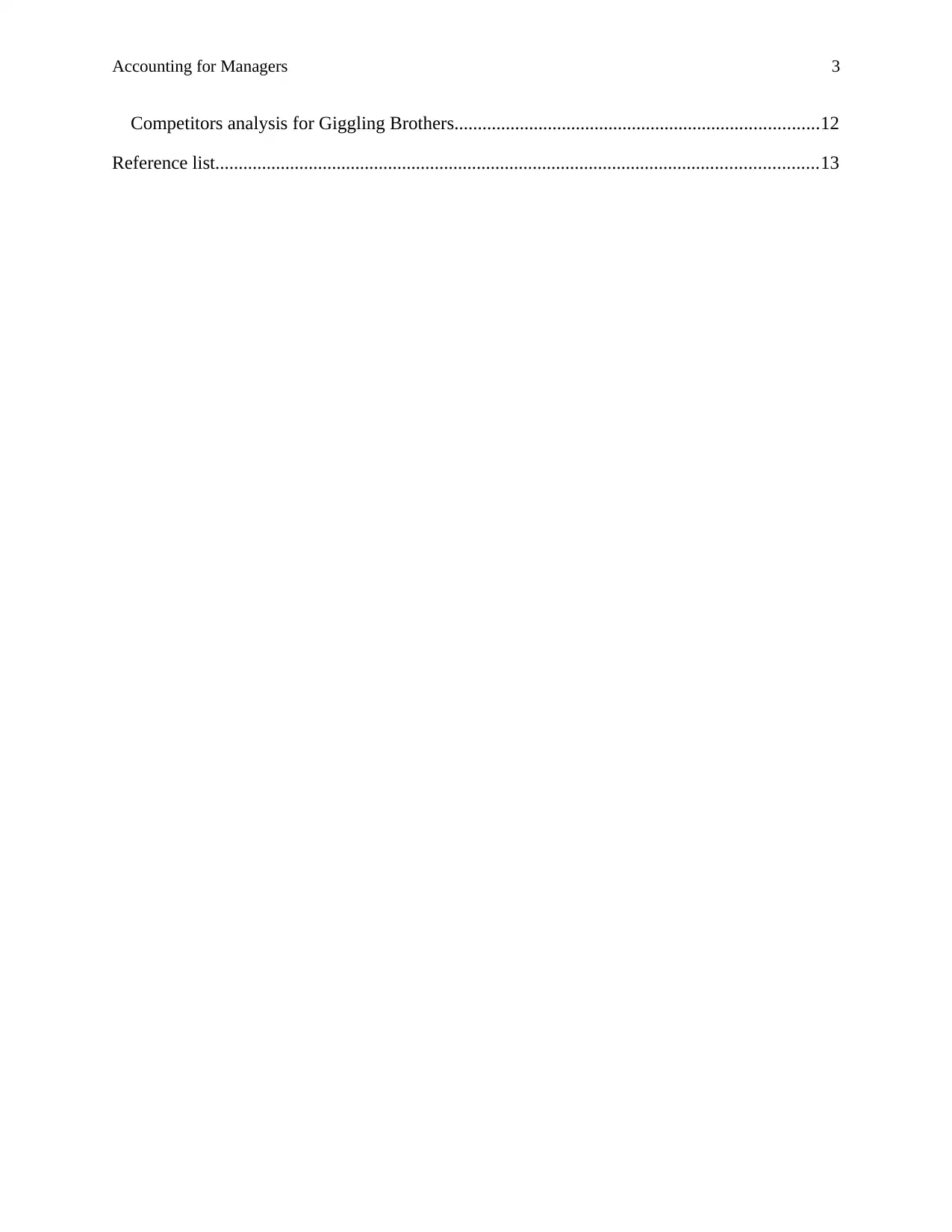
Accounting for Managers 3
Competitors analysis for Giggling Brothers..............................................................................12
Reference list.................................................................................................................................13
Competitors analysis for Giggling Brothers..............................................................................12
Reference list.................................................................................................................................13
⊘ This is a preview!⊘
Do you want full access?
Subscribe today to unlock all pages.

Trusted by 1+ million students worldwide
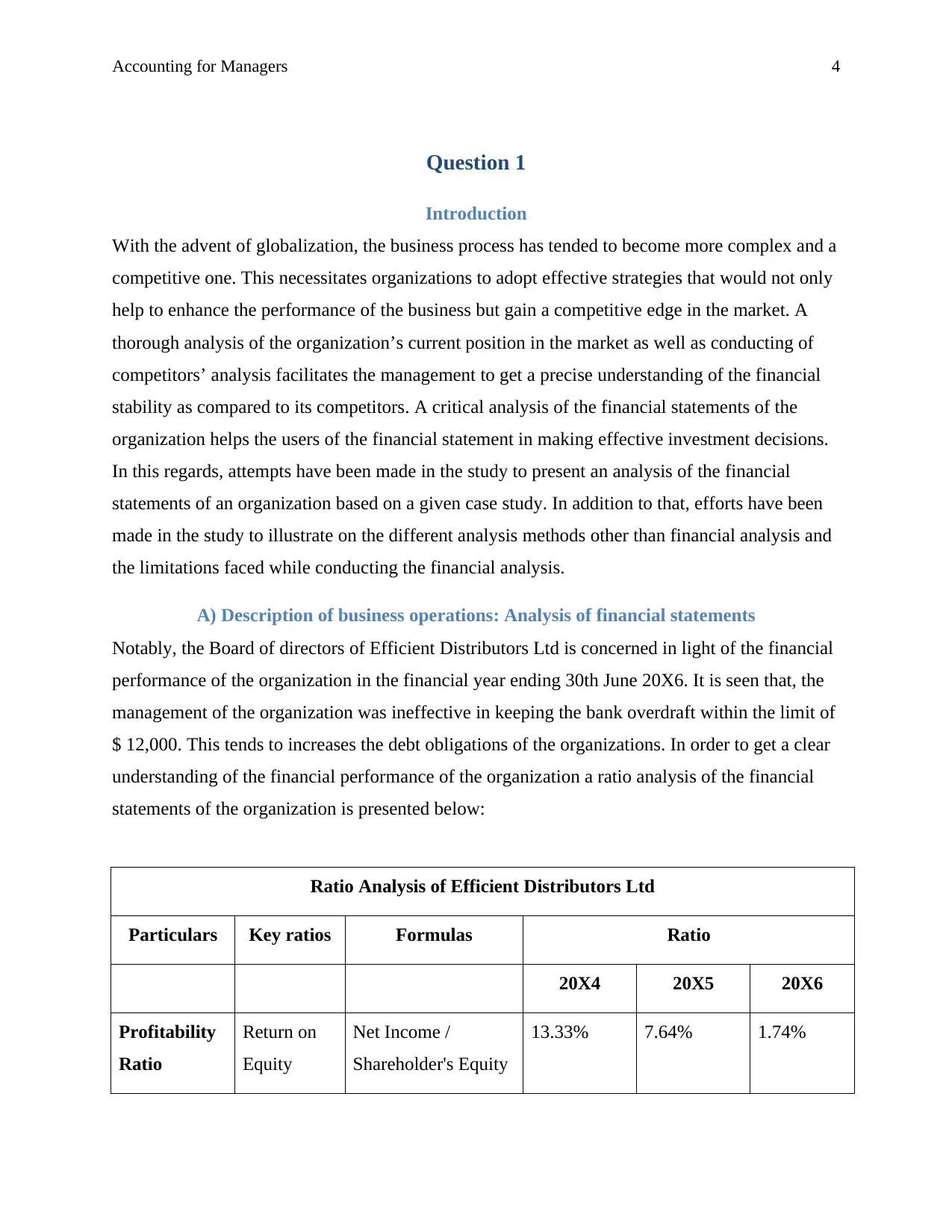
Accounting for Managers 4
Question 1
Introduction
With the advent of globalization, the business process has tended to become more complex and a
competitive one. This necessitates organizations to adopt effective strategies that would not only
help to enhance the performance of the business but gain a competitive edge in the market. A
thorough analysis of the organization’s current position in the market as well as conducting of
competitors’ analysis facilitates the management to get a precise understanding of the financial
stability as compared to its competitors. A critical analysis of the financial statements of the
organization helps the users of the financial statement in making effective investment decisions.
In this regards, attempts have been made in the study to present an analysis of the financial
statements of an organization based on a given case study. In addition to that, efforts have been
made in the study to illustrate on the different analysis methods other than financial analysis and
the limitations faced while conducting the financial analysis.
A) Description of business operations: Analysis of financial statements
Notably, the Board of directors of Efficient Distributors Ltd is concerned in light of the financial
performance of the organization in the financial year ending 30th June 20X6. It is seen that, the
management of the organization was ineffective in keeping the bank overdraft within the limit of
$ 12,000. This tends to increases the debt obligations of the organizations. In order to get a clear
understanding of the financial performance of the organization a ratio analysis of the financial
statements of the organization is presented below:
Ratio Analysis of Efficient Distributors Ltd
Particulars Key ratios Formulas Ratio
20X4 20X5 20X6
Profitability
Ratio
Return on
Equity
Net Income /
Shareholder's Equity
13.33% 7.64% 1.74%
Question 1
Introduction
With the advent of globalization, the business process has tended to become more complex and a
competitive one. This necessitates organizations to adopt effective strategies that would not only
help to enhance the performance of the business but gain a competitive edge in the market. A
thorough analysis of the organization’s current position in the market as well as conducting of
competitors’ analysis facilitates the management to get a precise understanding of the financial
stability as compared to its competitors. A critical analysis of the financial statements of the
organization helps the users of the financial statement in making effective investment decisions.
In this regards, attempts have been made in the study to present an analysis of the financial
statements of an organization based on a given case study. In addition to that, efforts have been
made in the study to illustrate on the different analysis methods other than financial analysis and
the limitations faced while conducting the financial analysis.
A) Description of business operations: Analysis of financial statements
Notably, the Board of directors of Efficient Distributors Ltd is concerned in light of the financial
performance of the organization in the financial year ending 30th June 20X6. It is seen that, the
management of the organization was ineffective in keeping the bank overdraft within the limit of
$ 12,000. This tends to increases the debt obligations of the organizations. In order to get a clear
understanding of the financial performance of the organization a ratio analysis of the financial
statements of the organization is presented below:
Ratio Analysis of Efficient Distributors Ltd
Particulars Key ratios Formulas Ratio
20X4 20X5 20X6
Profitability
Ratio
Return on
Equity
Net Income /
Shareholder's Equity
13.33% 7.64% 1.74%
Paraphrase This Document
Need a fresh take? Get an instant paraphrase of this document with our AI Paraphraser
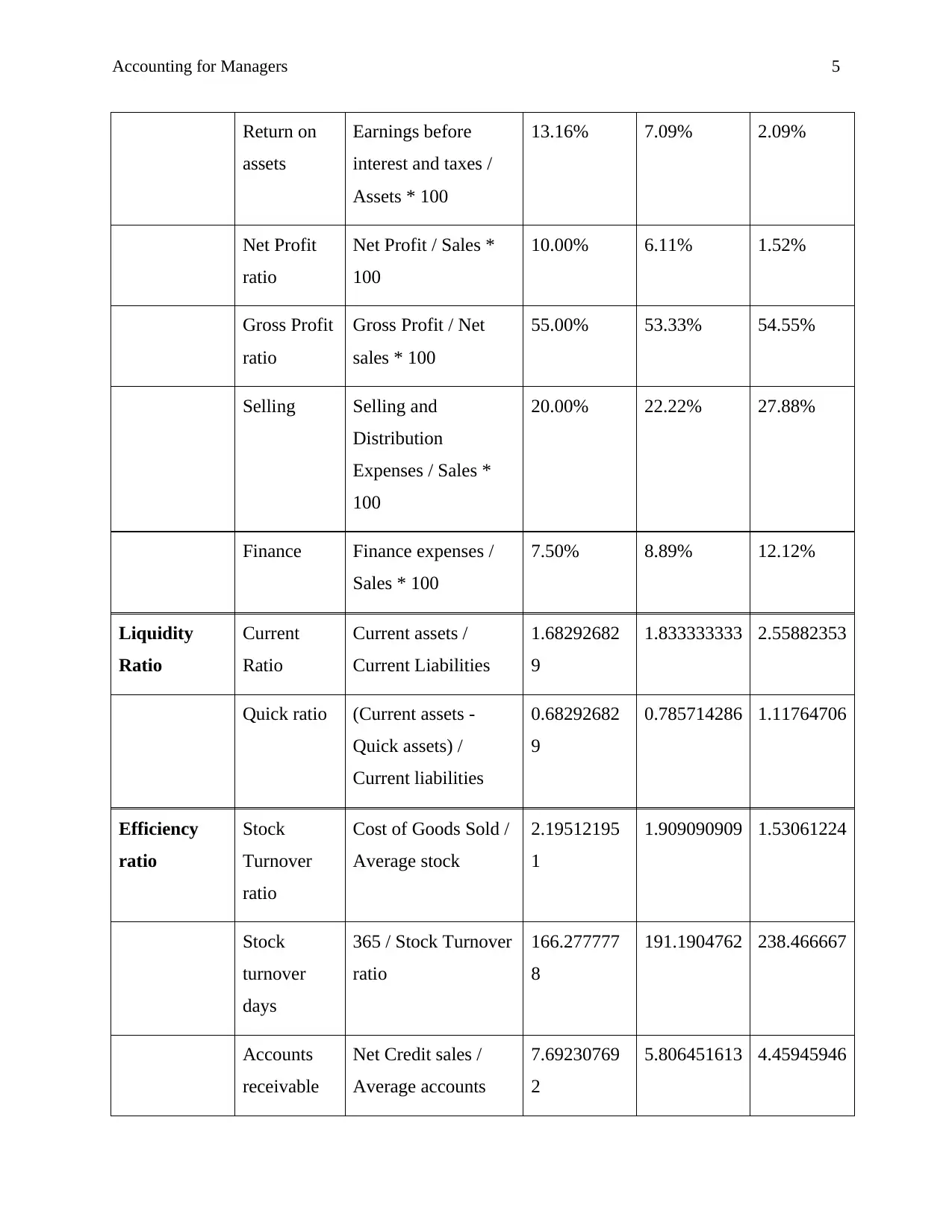
Accounting for Managers 5
Return on
assets
Earnings before
interest and taxes /
Assets * 100
13.16% 7.09% 2.09%
Net Profit
ratio
Net Profit / Sales *
100
10.00% 6.11% 1.52%
Gross Profit
ratio
Gross Profit / Net
sales * 100
55.00% 53.33% 54.55%
Selling Selling and
Distribution
Expenses / Sales *
100
20.00% 22.22% 27.88%
Finance Finance expenses /
Sales * 100
7.50% 8.89% 12.12%
Liquidity
Ratio
Current
Ratio
Current assets /
Current Liabilities
1.68292682
9
1.833333333 2.55882353
Quick ratio (Current assets -
Quick assets) /
Current liabilities
0.68292682
9
0.785714286 1.11764706
Efficiency
ratio
Stock
Turnover
ratio
Cost of Goods Sold /
Average stock
2.19512195
1
1.909090909 1.53061224
Stock
turnover
days
365 / Stock Turnover
ratio
166.277777
8
191.1904762 238.466667
Accounts
receivable
Net Credit sales /
Average accounts
7.69230769
2
5.806451613 4.45945946
Return on
assets
Earnings before
interest and taxes /
Assets * 100
13.16% 7.09% 2.09%
Net Profit
ratio
Net Profit / Sales *
100
10.00% 6.11% 1.52%
Gross Profit
ratio
Gross Profit / Net
sales * 100
55.00% 53.33% 54.55%
Selling Selling and
Distribution
Expenses / Sales *
100
20.00% 22.22% 27.88%
Finance Finance expenses /
Sales * 100
7.50% 8.89% 12.12%
Liquidity
Ratio
Current
Ratio
Current assets /
Current Liabilities
1.68292682
9
1.833333333 2.55882353
Quick ratio (Current assets -
Quick assets) /
Current liabilities
0.68292682
9
0.785714286 1.11764706
Efficiency
ratio
Stock
Turnover
ratio
Cost of Goods Sold /
Average stock
2.19512195
1
1.909090909 1.53061224
Stock
turnover
days
365 / Stock Turnover
ratio
166.277777
8
191.1904762 238.466667
Accounts
receivable
Net Credit sales /
Average accounts
7.69230769
2
5.806451613 4.45945946
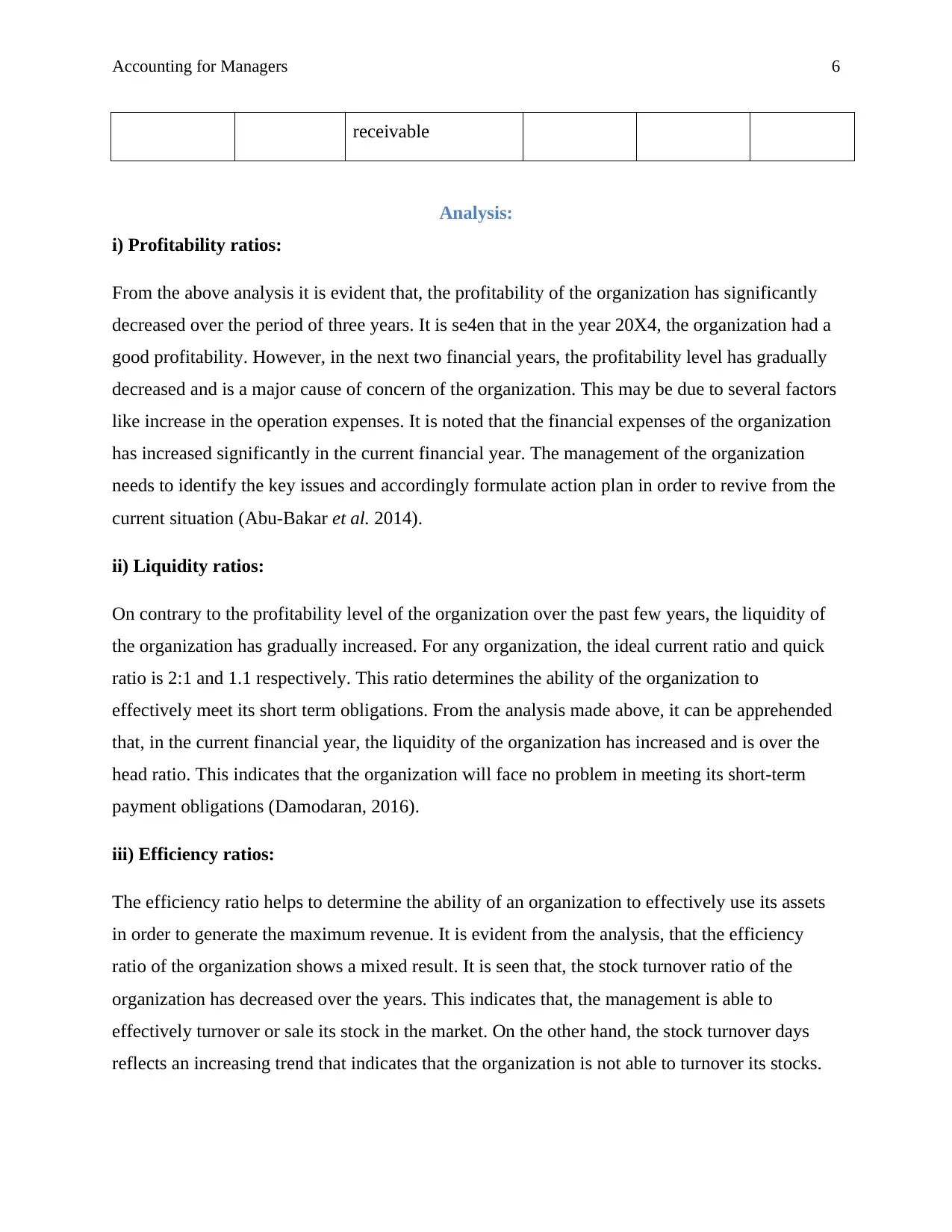
Accounting for Managers 6
receivable
Analysis:
i) Profitability ratios:
From the above analysis it is evident that, the profitability of the organization has significantly
decreased over the period of three years. It is se4en that in the year 20X4, the organization had a
good profitability. However, in the next two financial years, the profitability level has gradually
decreased and is a major cause of concern of the organization. This may be due to several factors
like increase in the operation expenses. It is noted that the financial expenses of the organization
has increased significantly in the current financial year. The management of the organization
needs to identify the key issues and accordingly formulate action plan in order to revive from the
current situation (Abu-Bakar et al. 2014).
ii) Liquidity ratios:
On contrary to the profitability level of the organization over the past few years, the liquidity of
the organization has gradually increased. For any organization, the ideal current ratio and quick
ratio is 2:1 and 1.1 respectively. This ratio determines the ability of the organization to
effectively meet its short term obligations. From the analysis made above, it can be apprehended
that, in the current financial year, the liquidity of the organization has increased and is over the
head ratio. This indicates that the organization will face no problem in meeting its short-term
payment obligations (Damodaran, 2016).
iii) Efficiency ratios:
The efficiency ratio helps to determine the ability of an organization to effectively use its assets
in order to generate the maximum revenue. It is evident from the analysis, that the efficiency
ratio of the organization shows a mixed result. It is seen that, the stock turnover ratio of the
organization has decreased over the years. This indicates that, the management is able to
effectively turnover or sale its stock in the market. On the other hand, the stock turnover days
reflects an increasing trend that indicates that the organization is not able to turnover its stocks.
receivable
Analysis:
i) Profitability ratios:
From the above analysis it is evident that, the profitability of the organization has significantly
decreased over the period of three years. It is se4en that in the year 20X4, the organization had a
good profitability. However, in the next two financial years, the profitability level has gradually
decreased and is a major cause of concern of the organization. This may be due to several factors
like increase in the operation expenses. It is noted that the financial expenses of the organization
has increased significantly in the current financial year. The management of the organization
needs to identify the key issues and accordingly formulate action plan in order to revive from the
current situation (Abu-Bakar et al. 2014).
ii) Liquidity ratios:
On contrary to the profitability level of the organization over the past few years, the liquidity of
the organization has gradually increased. For any organization, the ideal current ratio and quick
ratio is 2:1 and 1.1 respectively. This ratio determines the ability of the organization to
effectively meet its short term obligations. From the analysis made above, it can be apprehended
that, in the current financial year, the liquidity of the organization has increased and is over the
head ratio. This indicates that the organization will face no problem in meeting its short-term
payment obligations (Damodaran, 2016).
iii) Efficiency ratios:
The efficiency ratio helps to determine the ability of an organization to effectively use its assets
in order to generate the maximum revenue. It is evident from the analysis, that the efficiency
ratio of the organization shows a mixed result. It is seen that, the stock turnover ratio of the
organization has decreased over the years. This indicates that, the management is able to
effectively turnover or sale its stock in the market. On the other hand, the stock turnover days
reflects an increasing trend that indicates that the organization is not able to turnover its stocks.
⊘ This is a preview!⊘
Do you want full access?
Subscribe today to unlock all pages.

Trusted by 1+ million students worldwide
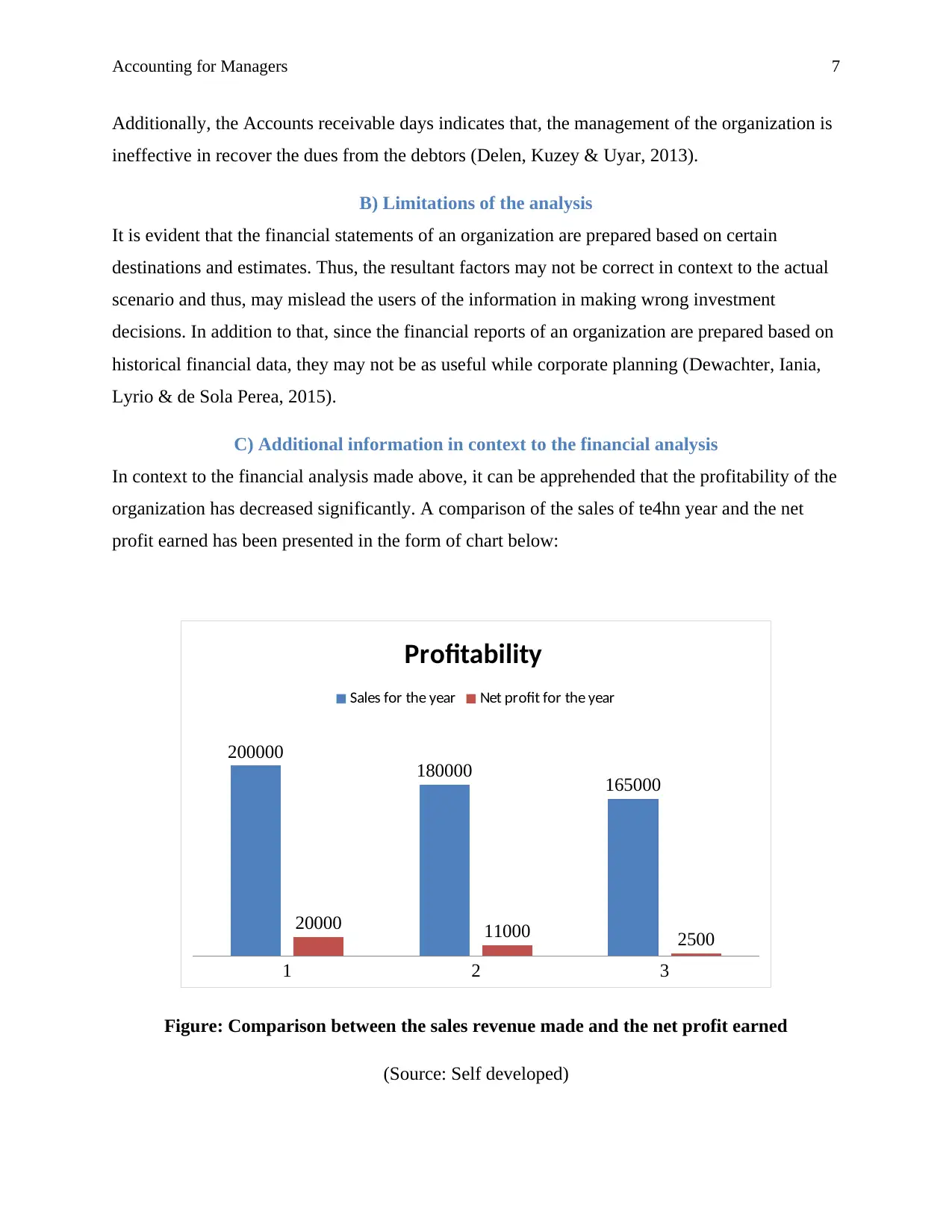
Accounting for Managers 7
Additionally, the Accounts receivable days indicates that, the management of the organization is
ineffective in recover the dues from the debtors (Delen, Kuzey & Uyar, 2013).
B) Limitations of the analysis
It is evident that the financial statements of an organization are prepared based on certain
destinations and estimates. Thus, the resultant factors may not be correct in context to the actual
scenario and thus, may mislead the users of the information in making wrong investment
decisions. In addition to that, since the financial reports of an organization are prepared based on
historical financial data, they may not be as useful while corporate planning (Dewachter, Iania,
Lyrio & de Sola Perea, 2015).
C) Additional information in context to the financial analysis
In context to the financial analysis made above, it can be apprehended that the profitability of the
organization has decreased significantly. A comparison of the sales of te4hn year and the net
profit earned has been presented in the form of chart below:
1 2 3
200000
180000 165000
20000 11000 2500
Profitability
Sales for the year Net profit for the year
Figure: Comparison between the sales revenue made and the net profit earned
(Source: Self developed)
Additionally, the Accounts receivable days indicates that, the management of the organization is
ineffective in recover the dues from the debtors (Delen, Kuzey & Uyar, 2013).
B) Limitations of the analysis
It is evident that the financial statements of an organization are prepared based on certain
destinations and estimates. Thus, the resultant factors may not be correct in context to the actual
scenario and thus, may mislead the users of the information in making wrong investment
decisions. In addition to that, since the financial reports of an organization are prepared based on
historical financial data, they may not be as useful while corporate planning (Dewachter, Iania,
Lyrio & de Sola Perea, 2015).
C) Additional information in context to the financial analysis
In context to the financial analysis made above, it can be apprehended that the profitability of the
organization has decreased significantly. A comparison of the sales of te4hn year and the net
profit earned has been presented in the form of chart below:
1 2 3
200000
180000 165000
20000 11000 2500
Profitability
Sales for the year Net profit for the year
Figure: Comparison between the sales revenue made and the net profit earned
(Source: Self developed)
Paraphrase This Document
Need a fresh take? Get an instant paraphrase of this document with our AI Paraphraser
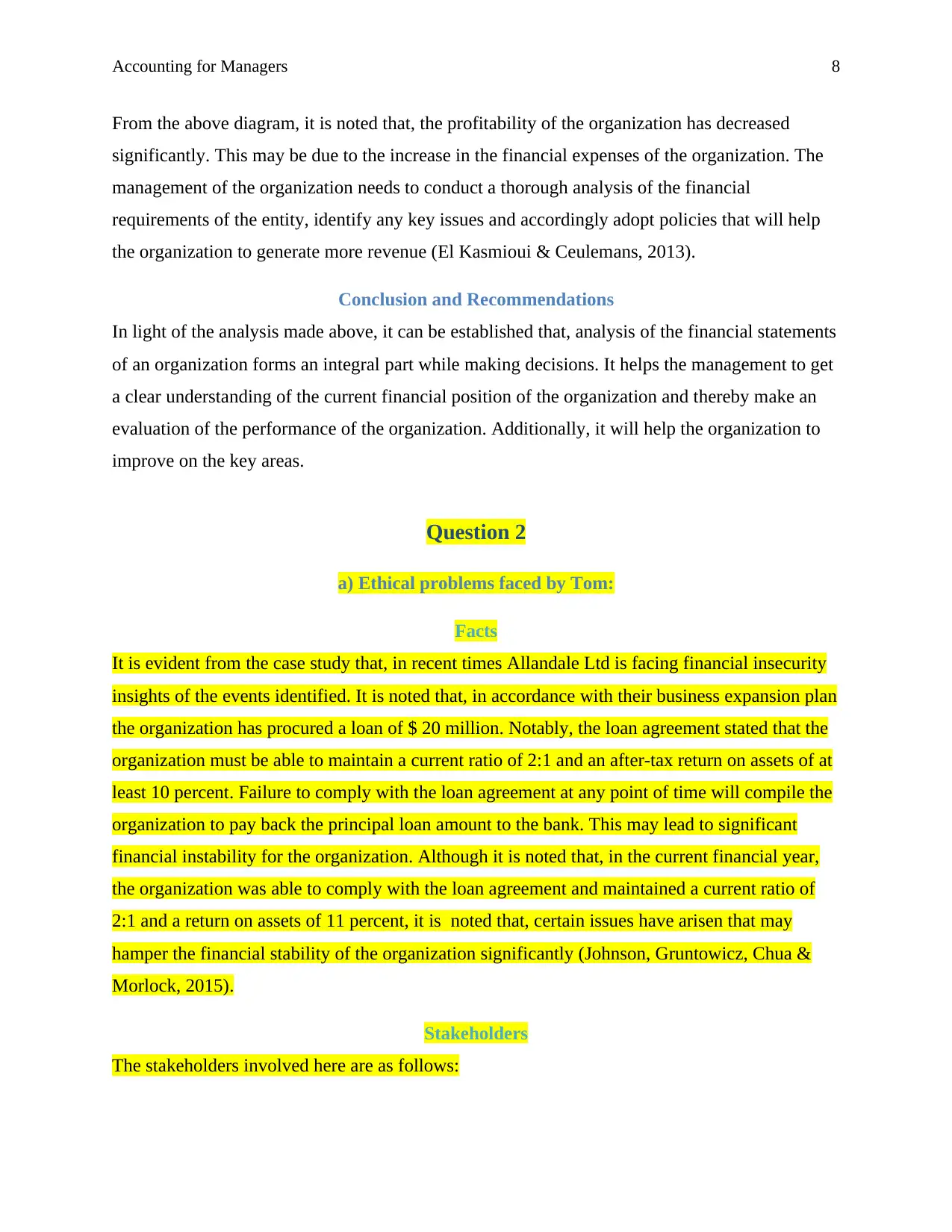
Accounting for Managers 8
From the above diagram, it is noted that, the profitability of the organization has decreased
significantly. This may be due to the increase in the financial expenses of the organization. The
management of the organization needs to conduct a thorough analysis of the financial
requirements of the entity, identify any key issues and accordingly adopt policies that will help
the organization to generate more revenue (El Kasmioui & Ceulemans, 2013).
Conclusion and Recommendations
In light of the analysis made above, it can be established that, analysis of the financial statements
of an organization forms an integral part while making decisions. It helps the management to get
a clear understanding of the current financial position of the organization and thereby make an
evaluation of the performance of the organization. Additionally, it will help the organization to
improve on the key areas.
Question 2
a) Ethical problems faced by Tom:
Facts
It is evident from the case study that, in recent times Allandale Ltd is facing financial insecurity
insights of the events identified. It is noted that, in accordance with their business expansion plan
the organization has procured a loan of $ 20 million. Notably, the loan agreement stated that the
organization must be able to maintain a current ratio of 2:1 and an after-tax return on assets of at
least 10 percent. Failure to comply with the loan agreement at any point of time will compile the
organization to pay back the principal loan amount to the bank. This may lead to significant
financial instability for the organization. Although it is noted that, in the current financial year,
the organization was able to comply with the loan agreement and maintained a current ratio of
2:1 and a return on assets of 11 percent, it is noted that, certain issues have arisen that may
hamper the financial stability of the organization significantly (Johnson, Gruntowicz, Chua &
Morlock, 2015).
Stakeholders
The stakeholders involved here are as follows:
From the above diagram, it is noted that, the profitability of the organization has decreased
significantly. This may be due to the increase in the financial expenses of the organization. The
management of the organization needs to conduct a thorough analysis of the financial
requirements of the entity, identify any key issues and accordingly adopt policies that will help
the organization to generate more revenue (El Kasmioui & Ceulemans, 2013).
Conclusion and Recommendations
In light of the analysis made above, it can be established that, analysis of the financial statements
of an organization forms an integral part while making decisions. It helps the management to get
a clear understanding of the current financial position of the organization and thereby make an
evaluation of the performance of the organization. Additionally, it will help the organization to
improve on the key areas.
Question 2
a) Ethical problems faced by Tom:
Facts
It is evident from the case study that, in recent times Allandale Ltd is facing financial insecurity
insights of the events identified. It is noted that, in accordance with their business expansion plan
the organization has procured a loan of $ 20 million. Notably, the loan agreement stated that the
organization must be able to maintain a current ratio of 2:1 and an after-tax return on assets of at
least 10 percent. Failure to comply with the loan agreement at any point of time will compile the
organization to pay back the principal loan amount to the bank. This may lead to significant
financial instability for the organization. Although it is noted that, in the current financial year,
the organization was able to comply with the loan agreement and maintained a current ratio of
2:1 and a return on assets of 11 percent, it is noted that, certain issues have arisen that may
hamper the financial stability of the organization significantly (Johnson, Gruntowicz, Chua &
Morlock, 2015).
Stakeholders
The stakeholders involved here are as follows:
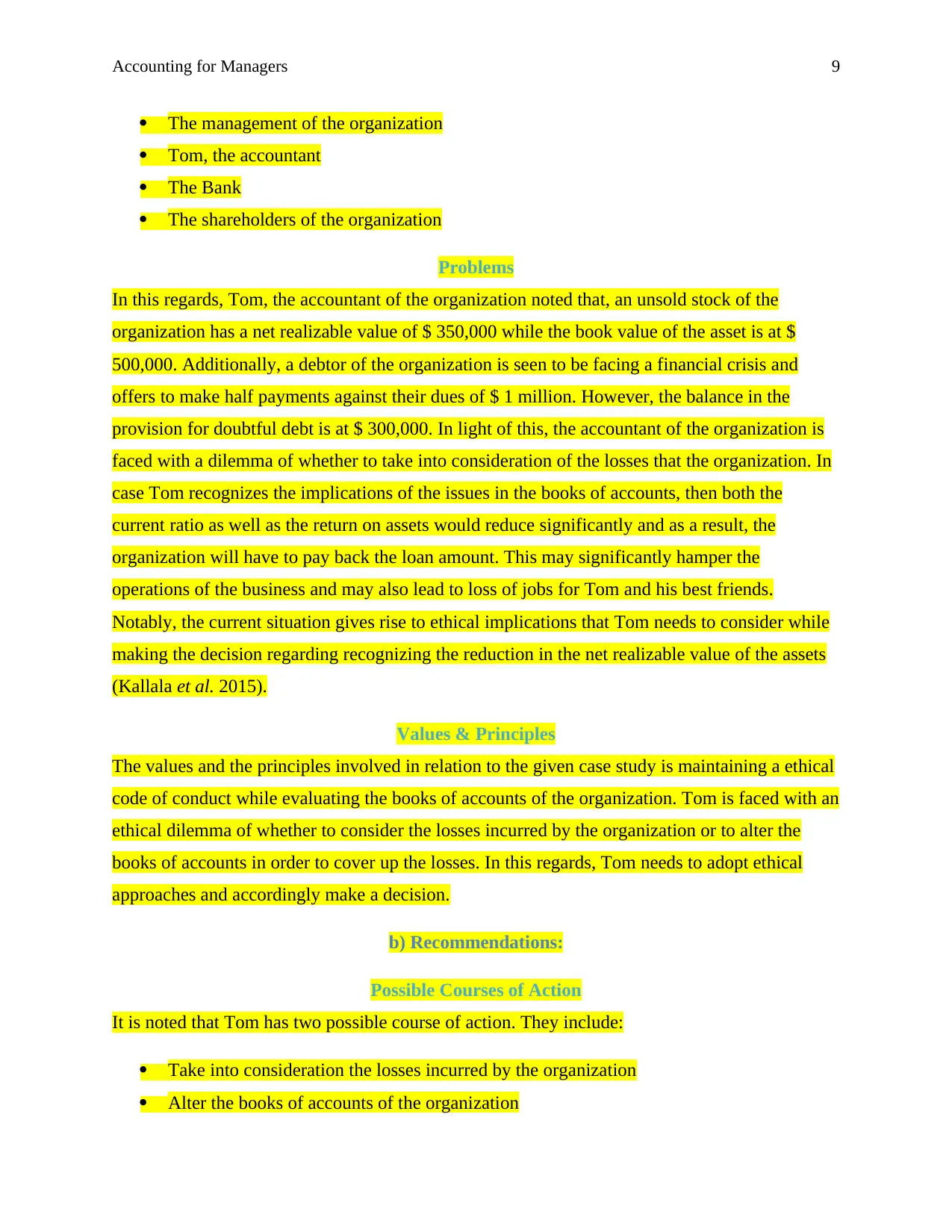
Accounting for Managers 9
The management of the organization
Tom, the accountant
The Bank
The shareholders of the organization
Problems
In this regards, Tom, the accountant of the organization noted that, an unsold stock of the
organization has a net realizable value of $ 350,000 while the book value of the asset is at $
500,000. Additionally, a debtor of the organization is seen to be facing a financial crisis and
offers to make half payments against their dues of $ 1 million. However, the balance in the
provision for doubtful debt is at $ 300,000. In light of this, the accountant of the organization is
faced with a dilemma of whether to take into consideration of the losses that the organization. In
case Tom recognizes the implications of the issues in the books of accounts, then both the
current ratio as well as the return on assets would reduce significantly and as a result, the
organization will have to pay back the loan amount. This may significantly hamper the
operations of the business and may also lead to loss of jobs for Tom and his best friends.
Notably, the current situation gives rise to ethical implications that Tom needs to consider while
making the decision regarding recognizing the reduction in the net realizable value of the assets
(Kallala et al. 2015).
Values & Principles
The values and the principles involved in relation to the given case study is maintaining a ethical
code of conduct while evaluating the books of accounts of the organization. Tom is faced with an
ethical dilemma of whether to consider the losses incurred by the organization or to alter the
books of accounts in order to cover up the losses. In this regards, Tom needs to adopt ethical
approaches and accordingly make a decision.
b) Recommendations:
Possible Courses of Action
It is noted that Tom has two possible course of action. They include:
Take into consideration the losses incurred by the organization
Alter the books of accounts of the organization
The management of the organization
Tom, the accountant
The Bank
The shareholders of the organization
Problems
In this regards, Tom, the accountant of the organization noted that, an unsold stock of the
organization has a net realizable value of $ 350,000 while the book value of the asset is at $
500,000. Additionally, a debtor of the organization is seen to be facing a financial crisis and
offers to make half payments against their dues of $ 1 million. However, the balance in the
provision for doubtful debt is at $ 300,000. In light of this, the accountant of the organization is
faced with a dilemma of whether to take into consideration of the losses that the organization. In
case Tom recognizes the implications of the issues in the books of accounts, then both the
current ratio as well as the return on assets would reduce significantly and as a result, the
organization will have to pay back the loan amount. This may significantly hamper the
operations of the business and may also lead to loss of jobs for Tom and his best friends.
Notably, the current situation gives rise to ethical implications that Tom needs to consider while
making the decision regarding recognizing the reduction in the net realizable value of the assets
(Kallala et al. 2015).
Values & Principles
The values and the principles involved in relation to the given case study is maintaining a ethical
code of conduct while evaluating the books of accounts of the organization. Tom is faced with an
ethical dilemma of whether to consider the losses incurred by the organization or to alter the
books of accounts in order to cover up the losses. In this regards, Tom needs to adopt ethical
approaches and accordingly make a decision.
b) Recommendations:
Possible Courses of Action
It is noted that Tom has two possible course of action. They include:
Take into consideration the losses incurred by the organization
Alter the books of accounts of the organization
⊘ This is a preview!⊘
Do you want full access?
Subscribe today to unlock all pages.

Trusted by 1+ million students worldwide
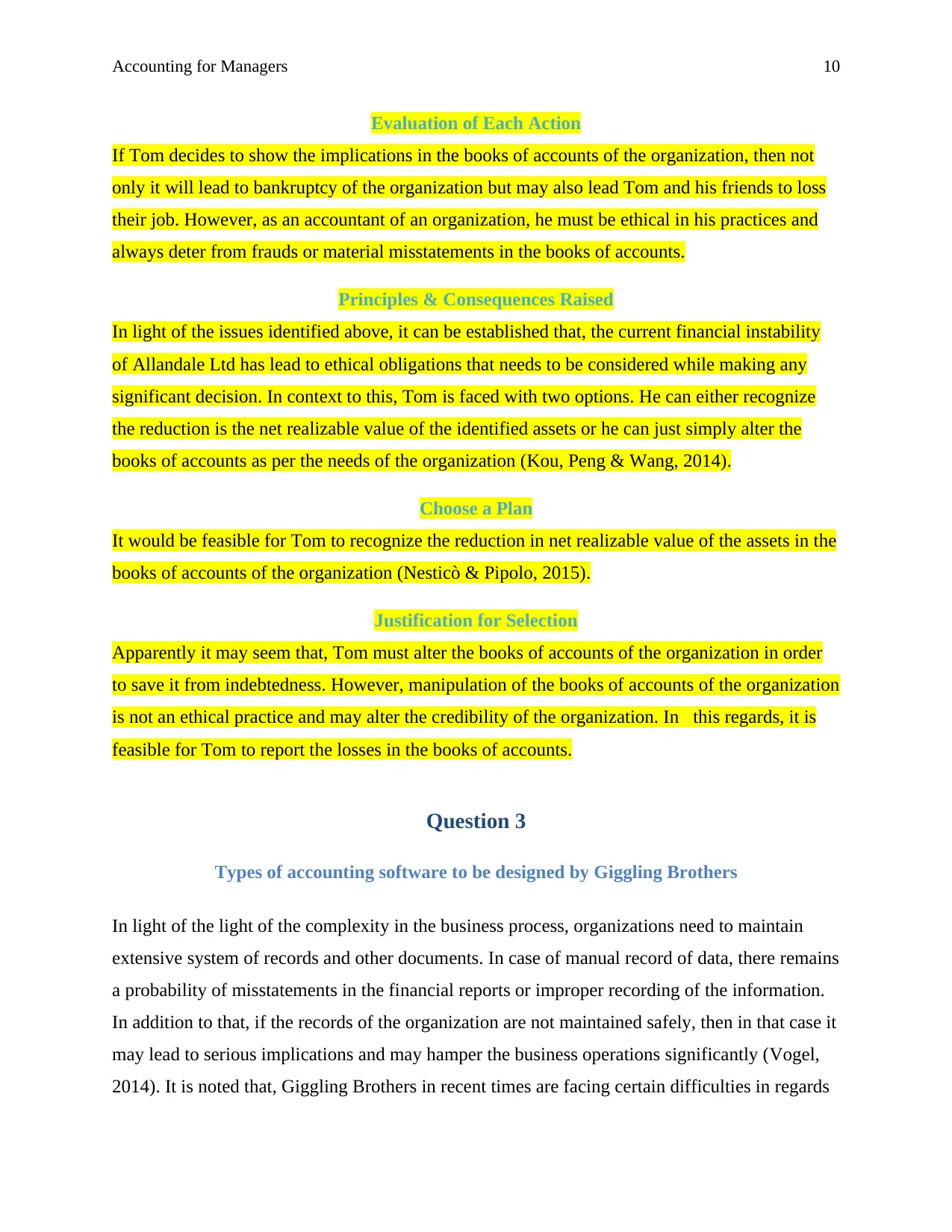
Accounting for Managers 10
Evaluation of Each Action
If Tom decides to show the implications in the books of accounts of the organization, then not
only it will lead to bankruptcy of the organization but may also lead Tom and his friends to loss
their job. However, as an accountant of an organization, he must be ethical in his practices and
always deter from frauds or material misstatements in the books of accounts.
Principles & Consequences Raised
In light of the issues identified above, it can be established that, the current financial instability
of Allandale Ltd has lead to ethical obligations that needs to be considered while making any
significant decision. In context to this, Tom is faced with two options. He can either recognize
the reduction is the net realizable value of the identified assets or he can just simply alter the
books of accounts as per the needs of the organization (Kou, Peng & Wang, 2014).
Choose a Plan
It would be feasible for Tom to recognize the reduction in net realizable value of the assets in the
books of accounts of the organization (Nesticò & Pipolo, 2015).
Justification for Selection
Apparently it may seem that, Tom must alter the books of accounts of the organization in order
to save it from indebtedness. However, manipulation of the books of accounts of the organization
is not an ethical practice and may alter the credibility of the organization. In this regards, it is
feasible for Tom to report the losses in the books of accounts.
Question 3
Types of accounting software to be designed by Giggling Brothers
In light of the light of the complexity in the business process, organizations need to maintain
extensive system of records and other documents. In case of manual record of data, there remains
a probability of misstatements in the financial reports or improper recording of the information.
In addition to that, if the records of the organization are not maintained safely, then in that case it
may lead to serious implications and may hamper the business operations significantly (Vogel,
2014). It is noted that, Giggling Brothers in recent times are facing certain difficulties in regards
Evaluation of Each Action
If Tom decides to show the implications in the books of accounts of the organization, then not
only it will lead to bankruptcy of the organization but may also lead Tom and his friends to loss
their job. However, as an accountant of an organization, he must be ethical in his practices and
always deter from frauds or material misstatements in the books of accounts.
Principles & Consequences Raised
In light of the issues identified above, it can be established that, the current financial instability
of Allandale Ltd has lead to ethical obligations that needs to be considered while making any
significant decision. In context to this, Tom is faced with two options. He can either recognize
the reduction is the net realizable value of the identified assets or he can just simply alter the
books of accounts as per the needs of the organization (Kou, Peng & Wang, 2014).
Choose a Plan
It would be feasible for Tom to recognize the reduction in net realizable value of the assets in the
books of accounts of the organization (Nesticò & Pipolo, 2015).
Justification for Selection
Apparently it may seem that, Tom must alter the books of accounts of the organization in order
to save it from indebtedness. However, manipulation of the books of accounts of the organization
is not an ethical practice and may alter the credibility of the organization. In this regards, it is
feasible for Tom to report the losses in the books of accounts.
Question 3
Types of accounting software to be designed by Giggling Brothers
In light of the light of the complexity in the business process, organizations need to maintain
extensive system of records and other documents. In case of manual record of data, there remains
a probability of misstatements in the financial reports or improper recording of the information.
In addition to that, if the records of the organization are not maintained safely, then in that case it
may lead to serious implications and may hamper the business operations significantly (Vogel,
2014). It is noted that, Giggling Brothers in recent times are facing certain difficulties in regards
Paraphrase This Document
Need a fresh take? Get an instant paraphrase of this document with our AI Paraphraser
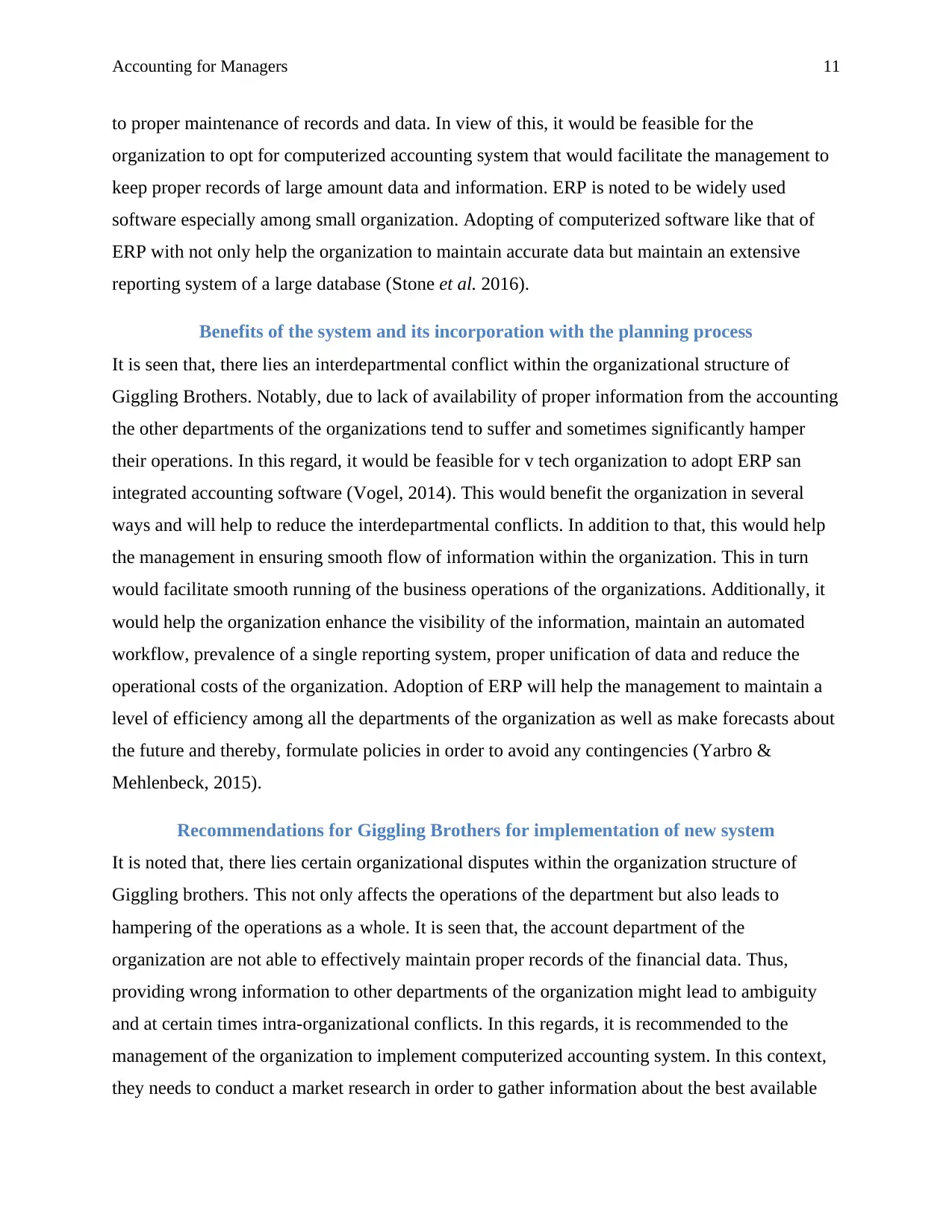
Accounting for Managers 11
to proper maintenance of records and data. In view of this, it would be feasible for the
organization to opt for computerized accounting system that would facilitate the management to
keep proper records of large amount data and information. ERP is noted to be widely used
software especially among small organization. Adopting of computerized software like that of
ERP with not only help the organization to maintain accurate data but maintain an extensive
reporting system of a large database (Stone et al. 2016).
Benefits of the system and its incorporation with the planning process
It is seen that, there lies an interdepartmental conflict within the organizational structure of
Giggling Brothers. Notably, due to lack of availability of proper information from the accounting
the other departments of the organizations tend to suffer and sometimes significantly hamper
their operations. In this regard, it would be feasible for v tech organization to adopt ERP san
integrated accounting software (Vogel, 2014). This would benefit the organization in several
ways and will help to reduce the interdepartmental conflicts. In addition to that, this would help
the management in ensuring smooth flow of information within the organization. This in turn
would facilitate smooth running of the business operations of the organizations. Additionally, it
would help the organization enhance the visibility of the information, maintain an automated
workflow, prevalence of a single reporting system, proper unification of data and reduce the
operational costs of the organization. Adoption of ERP will help the management to maintain a
level of efficiency among all the departments of the organization as well as make forecasts about
the future and thereby, formulate policies in order to avoid any contingencies (Yarbro &
Mehlenbeck, 2015).
Recommendations for Giggling Brothers for implementation of new system
It is noted that, there lies certain organizational disputes within the organization structure of
Giggling brothers. This not only affects the operations of the department but also leads to
hampering of the operations as a whole. It is seen that, the account department of the
organization are not able to effectively maintain proper records of the financial data. Thus,
providing wrong information to other departments of the organization might lead to ambiguity
and at certain times intra-organizational conflicts. In this regards, it is recommended to the
management of the organization to implement computerized accounting system. In this context,
they needs to conduct a market research in order to gather information about the best available
to proper maintenance of records and data. In view of this, it would be feasible for the
organization to opt for computerized accounting system that would facilitate the management to
keep proper records of large amount data and information. ERP is noted to be widely used
software especially among small organization. Adopting of computerized software like that of
ERP with not only help the organization to maintain accurate data but maintain an extensive
reporting system of a large database (Stone et al. 2016).
Benefits of the system and its incorporation with the planning process
It is seen that, there lies an interdepartmental conflict within the organizational structure of
Giggling Brothers. Notably, due to lack of availability of proper information from the accounting
the other departments of the organizations tend to suffer and sometimes significantly hamper
their operations. In this regard, it would be feasible for v tech organization to adopt ERP san
integrated accounting software (Vogel, 2014). This would benefit the organization in several
ways and will help to reduce the interdepartmental conflicts. In addition to that, this would help
the management in ensuring smooth flow of information within the organization. This in turn
would facilitate smooth running of the business operations of the organizations. Additionally, it
would help the organization enhance the visibility of the information, maintain an automated
workflow, prevalence of a single reporting system, proper unification of data and reduce the
operational costs of the organization. Adoption of ERP will help the management to maintain a
level of efficiency among all the departments of the organization as well as make forecasts about
the future and thereby, formulate policies in order to avoid any contingencies (Yarbro &
Mehlenbeck, 2015).
Recommendations for Giggling Brothers for implementation of new system
It is noted that, there lies certain organizational disputes within the organization structure of
Giggling brothers. This not only affects the operations of the department but also leads to
hampering of the operations as a whole. It is seen that, the account department of the
organization are not able to effectively maintain proper records of the financial data. Thus,
providing wrong information to other departments of the organization might lead to ambiguity
and at certain times intra-organizational conflicts. In this regards, it is recommended to the
management of the organization to implement computerized accounting system. In this context,
they needs to conduct a market research in order to gather information about the best available
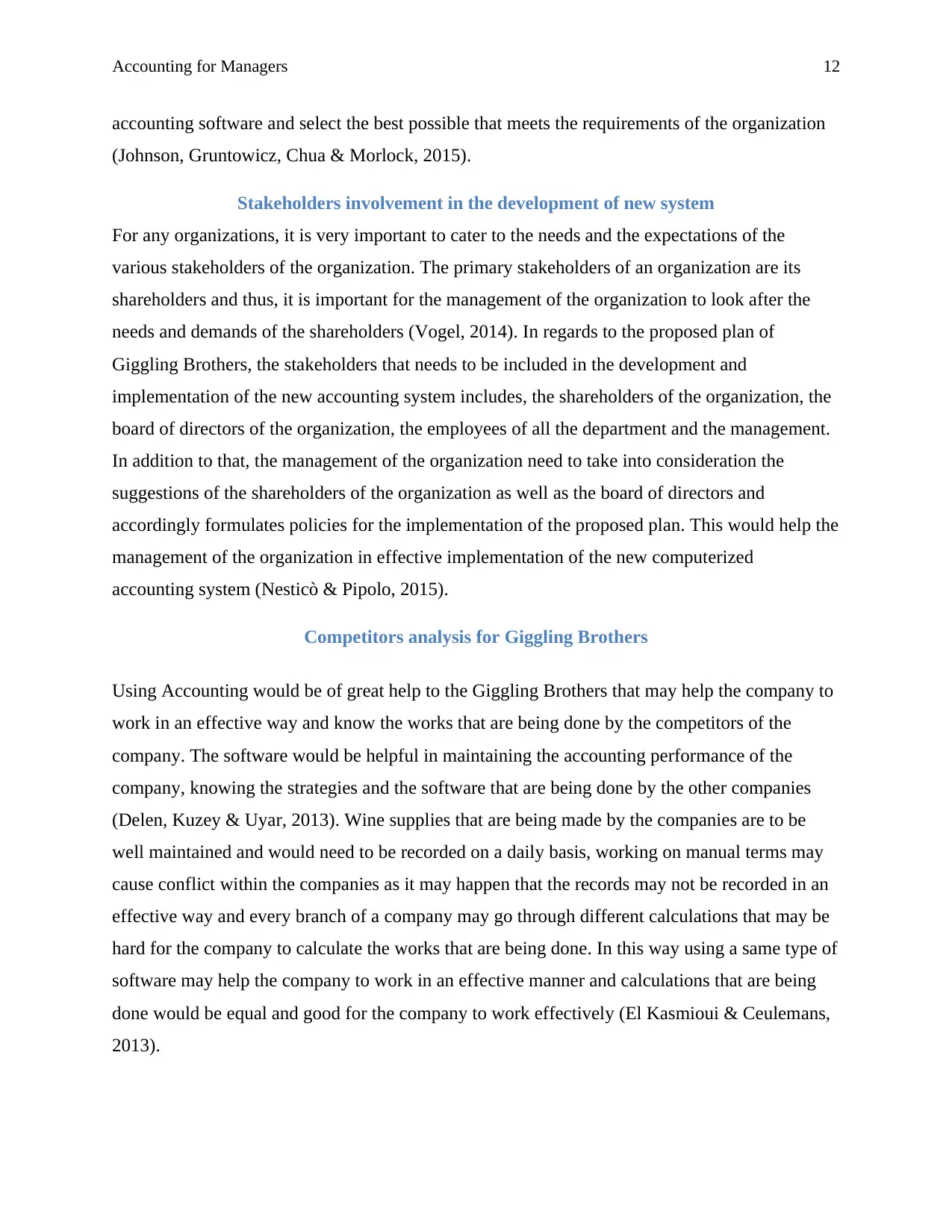
Accounting for Managers 12
accounting software and select the best possible that meets the requirements of the organization
(Johnson, Gruntowicz, Chua & Morlock, 2015).
Stakeholders involvement in the development of new system
For any organizations, it is very important to cater to the needs and the expectations of the
various stakeholders of the organization. The primary stakeholders of an organization are its
shareholders and thus, it is important for the management of the organization to look after the
needs and demands of the shareholders (Vogel, 2014). In regards to the proposed plan of
Giggling Brothers, the stakeholders that needs to be included in the development and
implementation of the new accounting system includes, the shareholders of the organization, the
board of directors of the organization, the employees of all the department and the management.
In addition to that, the management of the organization need to take into consideration the
suggestions of the shareholders of the organization as well as the board of directors and
accordingly formulates policies for the implementation of the proposed plan. This would help the
management of the organization in effective implementation of the new computerized
accounting system (Nesticò & Pipolo, 2015).
Competitors analysis for Giggling Brothers
Using Accounting would be of great help to the Giggling Brothers that may help the company to
work in an effective way and know the works that are being done by the competitors of the
company. The software would be helpful in maintaining the accounting performance of the
company, knowing the strategies and the software that are being done by the other companies
(Delen, Kuzey & Uyar, 2013). Wine supplies that are being made by the companies are to be
well maintained and would need to be recorded on a daily basis, working on manual terms may
cause conflict within the companies as it may happen that the records may not be recorded in an
effective way and every branch of a company may go through different calculations that may be
hard for the company to calculate the works that are being done. In this way using a same type of
software may help the company to work in an effective manner and calculations that are being
done would be equal and good for the company to work effectively (El Kasmioui & Ceulemans,
2013).
accounting software and select the best possible that meets the requirements of the organization
(Johnson, Gruntowicz, Chua & Morlock, 2015).
Stakeholders involvement in the development of new system
For any organizations, it is very important to cater to the needs and the expectations of the
various stakeholders of the organization. The primary stakeholders of an organization are its
shareholders and thus, it is important for the management of the organization to look after the
needs and demands of the shareholders (Vogel, 2014). In regards to the proposed plan of
Giggling Brothers, the stakeholders that needs to be included in the development and
implementation of the new accounting system includes, the shareholders of the organization, the
board of directors of the organization, the employees of all the department and the management.
In addition to that, the management of the organization need to take into consideration the
suggestions of the shareholders of the organization as well as the board of directors and
accordingly formulates policies for the implementation of the proposed plan. This would help the
management of the organization in effective implementation of the new computerized
accounting system (Nesticò & Pipolo, 2015).
Competitors analysis for Giggling Brothers
Using Accounting would be of great help to the Giggling Brothers that may help the company to
work in an effective way and know the works that are being done by the competitors of the
company. The software would be helpful in maintaining the accounting performance of the
company, knowing the strategies and the software that are being done by the other companies
(Delen, Kuzey & Uyar, 2013). Wine supplies that are being made by the companies are to be
well maintained and would need to be recorded on a daily basis, working on manual terms may
cause conflict within the companies as it may happen that the records may not be recorded in an
effective way and every branch of a company may go through different calculations that may be
hard for the company to calculate the works that are being done. In this way using a same type of
software may help the company to work in an effective manner and calculations that are being
done would be equal and good for the company to work effectively (El Kasmioui & Ceulemans,
2013).
⊘ This is a preview!⊘
Do you want full access?
Subscribe today to unlock all pages.

Trusted by 1+ million students worldwide
1 out of 14
Related Documents
Your All-in-One AI-Powered Toolkit for Academic Success.
+13062052269
info@desklib.com
Available 24*7 on WhatsApp / Email
![[object Object]](/_next/static/media/star-bottom.7253800d.svg)
Unlock your academic potential
Copyright © 2020–2025 A2Z Services. All Rights Reserved. Developed and managed by ZUCOL.





